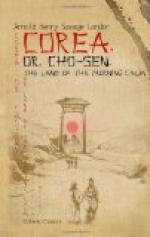The Corean is in some respects very sensible, if compared with his neighbours. Deformities, artificially produced, are never found in Corea. In civilised Japan, on the other hand, as we all know, the women blacken their teeth and shave their eyebrows, while there are numberless people in the lower classes who are tattooed from head to foot with designs of all kinds. In China, too, people are occasionally deformed for the sake of lucre, as, for instance, to be exhibited at village shows, and the Chinese damsel would not consider herself fascinating enough if her feet were not distorted to such an extent as to be shapeless, and almost useless. The head-bands worn by the men in Corea are probably the only causes which tend to modify the shape of their heads, and that only to a very small degree. These head-bands are worn so very tightly from their earliest youth, that I have often noticed men—when the head-band was removed—show a certain flattening of the upper part of the forehead, due undoubtedly to the continuous pressure of this head-gear. In such cases, however, the cranial deformation—though always noticeable—is but slight, and, of course, unintentionally caused. The skull, as a whole, in the case of those who have worn the head-band is a little more elongated than it is in the case of those few who have not; the elongation being upwards and slightly backwards.
Natural abnormalities are more frequent. I have seen numerous cases of goitre, and very often the so-called hare-lip. Webbed fingers also are frequently noticed; while inguinal hernia, both as a congenital and as an acquired affection, is unfortunately all too common. The natives do not undergo any special treatment until the complaint assumes alarming proportions, when a kind of belt is worn, or bandages of home manufacture are used. These are the more common abnormalities. To them, however, might also be added manifestations of albinism—though I have never seen an absolute albino in Corea—such as, large patches of white hair among the black. Red hair is rarely seen.
The Corean, apart, that is, from these occasional defects, is well proportioned, and of good carriage. When he stands erect his body is well-balanced; and when he walks, though somewhat hampered by his padded clothes, his step is rational. He sensibly walks with his toes turned slightly in, and he takes firm and long strides. The gait is not energetic, but, nevertheless, the Coreans are excellent pedestrians, and cover long distances daily, if only they are allowed plenty to eat and permission to smoke their long pipes from time to time. Their bodies seem very supple, and like those of nearly all Asiatics, their attitudes are invariably graceful. In walking, they slightly swing their arms and bend their bodies forward, except, I should say, the high officials, whose steps are exaggeratedly marked, and whose bodies are kept upright and purposely stiff.




